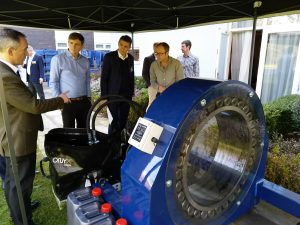Embracing disruptive digital technologies for the collection and analysis of wind-turbine data offers the best route to reducing the costs of operations and maintenance programs.
This is according to more than half (55 percent) of the asset and operations managers attending ONYX InSight’s European Technical Symposium in March.
Disruptive technology is entering the wind-energy sector quickly and helping to improve the cost-basis for running wind-turbine maintenance programs. From micro-electro mechanical sensors (MEMS) for gathering turbine data to machine learning algorithms that improve data analysis, owners and operators of wind farms in Europe need to embrace these technologies to maintain their position in the industry.
“Operators that continue to rely on traditional O&M practices to manage their profitability and overlook the rise of disruptive digital technologies risk losing out,” said Dr. John Coultate, head of Product Development at ONYX InSight. “Failure to embrace these technologies and apply them appropriately will see them overtaken by competitors able to reliably and profitably operate wind farms at lower cost.”
MEMS sensors, which lie at the heart of the digital disruption of wind-turbine monitoring, are produced annually in the billions at significantly lower cost than the piezoelectric sensors they are replacing. Greater versatility means MEMS sensors can be used to capture much more data about turbine behavior. MEMS sensors’ digital data outputs also eliminate the need for additional costly signal conditioning, making it easier for operators to run data analysis using another disruptive technology, machine learning.
A majority of attendees recognized the need for involving specialists to implement and harness the kinds of digital technologies that could be seen as disruptive. More than half said they recognized the need for third-party expertise to support digital integration and analysis of turbine data.
“The technology is here to stay, the only barrier to adoption is access to quality data,” said Dr. Xiaoqin Ma, head of Technology at ONYX InSight. “Machine learning can make sense out of large quantities of data that human analysts might find overwhelming. With vast amounts of data being collected through hundreds of channels from every single turbine every second, ML is essential for understanding turbine condition and reducing the cost of maintenance programs.”
“Properly trained machine learning algorithms, backed up by intelligent engineering experience, can add real value to the wind-energy industry,” he said. “Without the right support for quality data inputs and guidance from experts, however, users of machine learning, disappointed by its outputs, risk overlooking a powerful tool that will drive OPEX cost reductions into the future.”
Dr. Ma and Dr. Coultate were speaking to more than 50 wind asset and operations managers from across Europe, at the ONYX InSight Technical Symposium in Manchester. Presentations and panel discussions focused on the technology trends and adoption by wind-farm operators looking to drive lifetime extension and reduce the cost of operations and maintenance.
“The symposium once again proved itself a welcoming forum for operators to share experiences, freely discuss the challenges they face and learn and understand current best practices and solutions that will help them get the best form their assets,” said Bruce Hall, CEO of ONYX InSight.
More info www.onyxinsight.com



























